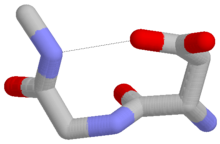The Asx turn[1][2][3][4][5][6][7] is a structural feature in proteins and polypeptides. It consists of three amino acid residues (labeled i, i+1 and i+2) in which residue i is an aspartate (Asp) or asparagine (Asn) that forms a hydrogen bond from its sidechain CO group to the mainchain NH group of residue i+2. About 14% of Asx residues present in proteins belong to Asx turns.
The name "Asx" is used here to represent either of the amino acids aspartate (Asp) or asparagine (Asn).
Types[edit]

Four types of Asx turn can be distinguished:[8] types I, I’, II and II’. These categories correspond to those of the better-known hydrogen-bonded beta turns, which have four residues and a hydrogen bond between the CO of residue i and the NH of residue i+3. Asx turns and beta turns have structurally similar hydrogen-bonded loops and exhibit sidechain-mainchain mimicry in the sense that the sidechain of residue i of the Asx turn mimics the mainchain of residue i of the beta turn. Regarding their occurrence in proteins, they differ in that type I is the commonest of the four beta turns while type II’ is the commonest of the Asx turns.
Occurrence[edit]
Asx and ST turns both occur frequently at the N-termini of α-helices.[9][10][11][12] as part of Asx motifs or ST motifs such that the Asx, serine or threonine is the N cap residue. They are thus often regarded as helix capping features.
Related motifs[edit]
Similar motifs occur with serine or threonine as residue i, which are called ST turns.[13] In spite of serine and threonine having one less sidechain atom, such that the sidechain-mainchain mimicry of β turns is imperfect, these features occur in proteins as the four types in numbers approaching those of Asx turns. They also exhibit a tendency to substitute each other over evolutionary time.[14]
A proportion of Asx turns are accompanied by a mainchain–mainchain hydrogen bond that qualifies them as Asx motifs.
References[edit]
- ^ Richardson, JS (1981). "The anatomy and taxonomy of protein structure". Advances in Protein Chemistry Volume 34. Vol. 34. pp. 167–339. doi:10.1016/S0065-3233(08)60520-3. ISBN 9780120342341. PMID 7020376.
- ^ Tainer, JA; Getzoff ED (1982). "Determination and analysis of the 2 A-structure of copper, zinc superoxide dismutase". Journal of Molecular Biology. 160 (2): 181–217. doi:10.1016/0022-2836(82)90174-7. PMID 7175933.
- ^ Rees, DC; Lewis M (1983). "Refined crystal structure of carboxypeptidase a at 1.54 Å resolution". Journal of Molecular Biology. 168 (2): 367–387. doi:10.1016/S0022-2836(83)80024-2. PMID 6887246.
- ^ Eswar, N; Ramachandran C (1999). "Secondary structures without backbone: An analysis of backbone mimicry by polar side chains in proteins". Protein Engineering. 12 (6): 447–455. doi:10.1093/protein/12.6.447. PMID 10388841.
- ^ Chakrabarti, P; Pal D (2001). "Interrelationships of side-chain and main-chain conformations in proteins". Progress in Biophysics and Molecular Biology. 76 (1–2): 1–102. doi:10.1016/s0079-6107(01)00005-0. PMID 11389934.
- ^ Duddy, WJ; Nissink WMJ; Allen, Frank H.; Milner-White, E. James (2004). "Mimicry by asx- and ST-turns of the four main types of β-turn in proteins". Protein Science. 13 (11): 3051–3055. doi:10.1110/ps.04920904. PMC 2286581. PMID 15459339.
- ^ Thakur, AK; Kishore R (2006). "Characterization of β-turn and asx-turns mimicry in a model peptide : Stabilization via C-H•••O interaction". Biopolymers. 81 (6): 440–449. doi:10.1002/bip.20441. PMID 16411188. S2CID 27091571.
- ^ Duddy, WJ; Nissink WMJ; Allen, Frank H.; Milner-White, E. James (2004). "Mimicry by asx- and ST-turns of the four main types of beta turn in proteins". Protein Science. 13 (11): 3051–3055. doi:10.1110/ps.04920904. PMC 2286581. PMID 15459339.
- ^ Doig, AJ; Macarthur MW; MacArthur, Malcolm W.; Thornton, Janet M. (1997). "Structures of N-termini of helices in proteins". Protein Science. 6 (1): 147–155. doi:10.1002/pro.5560060117. PMC 2143508. PMID 9007987.
- ^ Presta, LG; Rose GD (1988). "Helix Caps". Science. 240 (4859): 1632–1641. Bibcode:1988Sci...240.1632P. doi:10.1126/science.2837824. PMID 2837824.
- ^ Aurora, R; Rose GD (1998). "Helix Capping". Protein Science. 7 (1): 21–38. doi:10.1002/pro.5560070103. PMC 2143812. PMID 9514257.
- ^ Gunasekaran, K; Nagarajam HA; Ramakrishnan, C; Balaram, P (1998). "Stereochemical punctuation marks in protein structure". Journal of Molecular Biology. 275 (5): 917–932. doi:10.1006/jmbi.1997.1505. PMID 9480777. S2CID 35919397.
- ^ Duddy, WJ; Nissink WMJ; Allen, Frank H.; Milner-White, E. James (2004). "Mimicry by asx- and ST-turns of the four main types of β-turn in proteins". Protein Science. 13 (11): 3051–3055. doi:10.1110/ps.04920904. PMC 2286581. PMID 15459339.
- ^ Wan, W-Y; Milner-White EJ (2009). "A Recurring Two-Hydrogen-bond Motif Incorporating a Serine or Threonine Residue is found both at α-Helical N Termini and in Other Situations". Journal of Molecular Biology. 286 (5): 1651–1662. doi:10.1006/jmbi.1999.2551. PMID 10064721.
External links[edit]
- ^ Leader, DP; Milner-White EJ (2009). "Motivated Proteins: A web application for studying small three-dimensional protein motifs". BMC Bioinformatics. 10: 60. doi:10.1186/1471-2105-10-60. PMC 2651126. PMID 19210785.
- ^ Golovin, A; Henrick K (2008). "MSDmotif: exploring protein sites and motifs". BMC Bioinformatics. 9: 312. doi:10.1186/1471-2105-9-312. PMC 2491636. PMID 18637174.